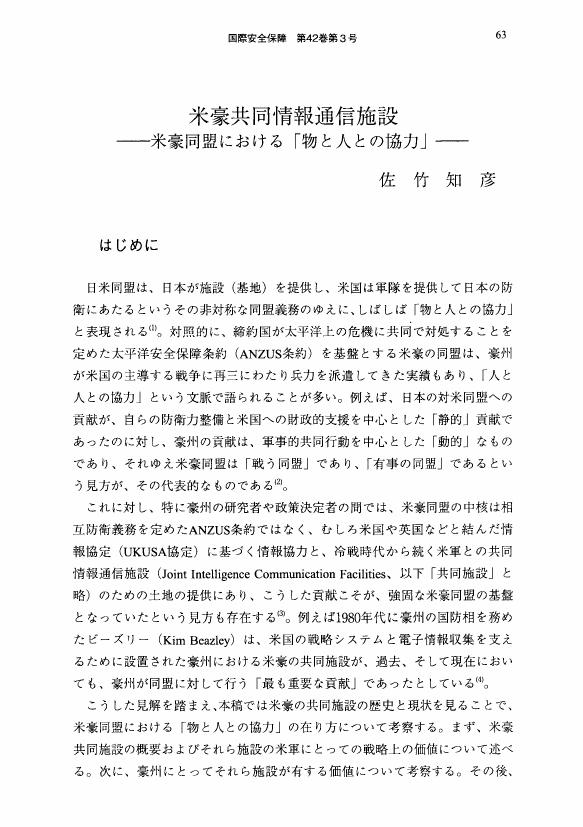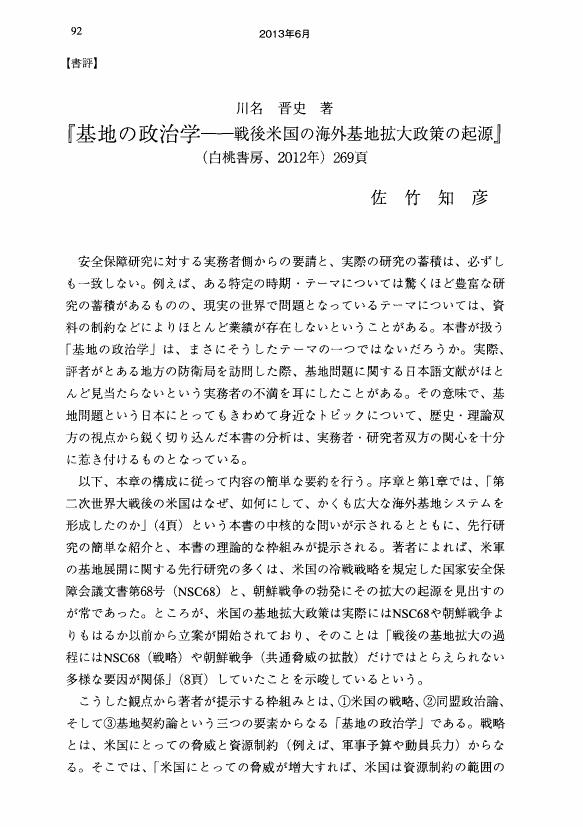1 0 0 0 OA 米豪共同情報通信施設 ――米豪同盟における「物と人との協力」――
- 著者
- 佐竹 知彦
- 出版者
- 国際安全保障学会
- 雑誌
- 国際安全保障 (ISSN:13467573)
- 巻号頁・発行日
- vol.42, no.3, pp.63-78, 2014-12-31 (Released:2022-04-07)
1 0 0 0 OA 川名 晋史 著『基地の政治学――戦後米国の海外基地拡大政策の起源』
- 著者
- 佐竹 知彦
- 出版者
- 国際安全保障学会
- 雑誌
- 国際安全保障 (ISSN:13467573)
- 巻号頁・発行日
- vol.41, no.1, pp.92-96, 2013-06-30 (Released:2022-04-07)
1 0 0 0 日米豪の安全保障協力 ――「ハブ&スポークス」体制の変容?――
- 著者
- 佐竹 知彦
- 出版者
- 一般財団法人 日本国際政治学会
- 雑誌
- 国際政治 (ISSN:04542215)
- 巻号頁・発行日
- vol.2022, no.206, pp.206_133-206_148, 2022-03-25 (Released:2022-03-31)
- 参考文献数
- 73
Since the end of the Cold War, the US allies in Asia such as Japan and Australia have enhanced their bilateral and trilateral security cooperation including the United States. Does it mean that, as some suggest, the US-led “hub and spokes” system—a bilateral alliance network centered on the US “hub” and regional allies as “spokes”—has transformed to a more “networked” alliance structure based on horizontal relations between the United States and regional allies?To answer this question, the paper first focuses on the asymmetric nature of the “hub and spokes” alliance system. Previous studies suggest that an asymmetric structure of the US alliance system in Asia—in a sense that regional allies do not assume defense obligations or burden which are equivalent to those of the United States—has prevented the emergence of the collective defense mechanism such as the North Atlantic Treaty Organization (NATO) in Europe. In particular, the US regional allies did not wish to establish a collective defense mechanism in Asia, so long as the United States continuously committed to regional allies’ defense bilaterally.This in turn suggests that, should the US security commitment become less credible, regional allies have greater incentives to enhance their mutual defense cooperation in order to prepare for the loss of security provided by the United States. Indeed, Japan and Australia began to enhance their security cooperation immediately after the Cold War, out of fear that the US military presence in the region would become weaken. In order to maintain the strong US military presence in the region, these two allies began to assume greater burden-sharing with the United States.Such cooperation continued after the 2000s, at which the rise of China became more prominent. In order to maintain the US strategic primacy in Asia, Japan and Australia actively contributed to the US-led global “war on terror”. Both countries also increased their roles in regional peacekeeping and humanitarian assistance and disaster reliefs activities. As a result, the trilateral security cooperation became institutionalized in the late 2000s. As such, trilateral security cooperation between Japan, the US and Australia have enhanced as Japan and Australia assumed greater burden and responsibilities in both regional and global security.This ostensibly suggests the transformation of the US alliance network from an asymmetrical “hub and spokes” system to a more symmetrical alliance network. In reality, however, these regional allies enhanced their security cooperation in order to maintain the US strategic primacy, so that they can continuously enjoy the US security commitment to them through bilateral alliance relations. This means that, quite ironically, the so-called “spokes to spokes” cooperation could help to endure, rather than transform, the existing hub and spokes system by maintaining its asymmetric alliance structure.
1 0 0 0 OA 豪州とインド太平洋 ―多極化時代における新たな秩序を求めて―
- 著者
- 佐竹 知彦
- 出版者
- 国際安全保障学会
- 雑誌
- 国際安全保障 (ISSN:13467573)
- 巻号頁・発行日
- vol.46, no.3, pp.51-70, 2018-12-31 (Released:2022-03-14)

